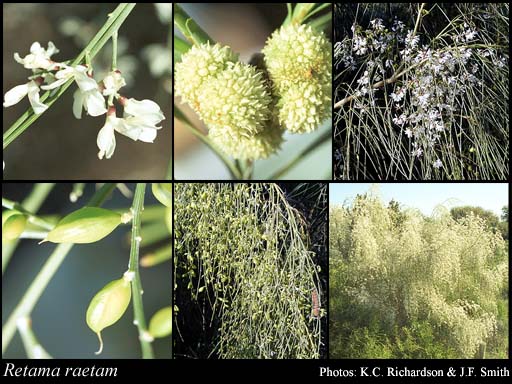- Reference
- Webb & Berthel., Hist.Nat.Iles Canaries (Phytogr.) 2:56 (1842)
- Conservation Code
- Not threatened
- Naturalised Status
- Alien to Western Australia
- Name Status
- Current
Slender, weeping shrub, to 3 m high. Fl. white, Jul to Sep. White or yellow sand, limestone. Coastal sand dunes, valleys, road verges.

Distribution
- IBRA Regions
- Jarrah Forest, Swan Coastal Plain.
- IBRA Subregions
- Northern Jarrah Forest, Perth.
- IMCRA Regions
- Central West Coast, Leeuwin-Naturaliste.
- Local Government Areas (LGAs)
- Bunbury, Busselton, Cambridge, Dardanup, Greater Geraldton, Joondalup, Melville, Mosman Park, Mundaring, Rockingham, Wanneroo, Waroona.
Management Notes (for the Swan NRM Region)
Alternative Names. Bridal Broom.
General Biology. Growth form. Shrub. Reproduction. Seed. Dispersal. Soil, water, garden waste, rabbits, inappropriate plantings, possibly also dispersed by ants. Time to first flowering. 2 years. Toxicity. Leaves, flowers and fruit toxic. Has been known to cause respiratory failure. Vegetative regeneration strategy. Resprouts. Seedbank persistence. Soil, long, 5+ years. Sets prolific, hard coated seed with medium to long term persistence up to 20 years. Fire response. Plants may be killed by very hot fire, however are likely to survive and resprout following less severe fires. Fire can also break seed dormancy, resulting in mass germination of seedlings.
Notes. Thought to be one of the most drought tolerant of the brooms. Juvenile plants have a deep tap root making hand removal difficult. Prefers calcareous soils in coastal and inland areas.
Additional information. Origin. North Africa/Mediterranean, including Algeria, Egypt, Libya, Morocco, Tunisia, Israel, Jordan, Lebanon. History of use/introduction. Originally introduced into South Australia as an ornamental. Later used in roadside plantings and for dune stabilisation. Similar exotic species. Retama monosperma, Spartum junceum (Spanish Broom).
Suggested method of management and control. Hand pull seedlings. For juvenile and mature plants, cut and paint with 50% glyphosate or basal bark with tricoplyr + diesel at 1.25 L/60 L. Monitor site for recruitment from seedbank. Read the manufacturers' labels and material safety data sheets before using herbicides. For further information consult the Australian Pesticides and Veterinary Medicines Authority to determine the status of permits for your situation or state.
Management Calendar
| Calendar Type | Jan | Feb | Mar | Apr | May | Jun | Jul | Aug | Sep | Oct | Nov | Dec | Comments |
|---|---|---|---|---|---|---|---|---|---|---|---|---|---|
| Dormant | O | O | O | O | |||||||||
| Active Growth | O | Y | Y | Y | Y | Y | Y | Y | Y | ||||
| Flowering | O | Y | Y | Y | Y | Y | O | ||||||
| Germination | Y | Y | Y | Y | Y | ||||||||
| Optimum Treatment | O | O | O | Y | Y | Y | Y | Y | Y | Y | Y | O |
Legend: Y = Yes, regularly, O = Occasionally, U = Uncertain, referred by others but not confirmed.
References
- Bettink, K.A. (2009) Determining best practice control methods for the national alert list species, white weeping broom (Retama raetam (Forssk.) Webb) in Western Australia. In Proceedings of the Western Australian Weeds Conference 2009: Fostering Solutions for the Future. Land & Water Australia, Weeds Society of WA & Botanic Gardens & Parks Authority Western Australian Ecology Centre, Bold Park, Floreat, Western Australia.
- Bettink, K.A. & Brown, K.L. (2011) Determining Best Control Methods for the National Environmental Alert List Species, Retama raetam(Forssk.) Webb (White Weeping Broom) in Western Australia. Plant Protection Quarterly, 26 (1).
- CRC Weed Management (2003) Weed Management Guide - White Weeping Broom - Retama raetam. Commonwealth Department of Environment and Heritage, Canberra, Australia.
- DeLaine, D. & Stokes, Z. (2006) Controlling Bushland Weeds on the Lower Eyre Peninsula. Rural Solutions, Adelaide, South Australia.
- El Bahri, L. Djegham M. & Bellil H. (2003) Retama raetam: A poisonous plant of North Africa. Veterinary & Human Toxicology, 41 (1): 33-35.
- Hussey, B.M.J., Keighery, G.J., Dodd, J., Lloyd, S.G. & Cousens, R.D. (2007) Western Weeds. A guide to the weeds of Western Australia. 2nd Edition. The Plant Protection Society of Western Australia, Victoria Park.
- Izhaki I. & Ne'eman G. (1997) Hares (Lepus spp.) as seed dispersers of Retama raetam (Fabaceae) in a sandy landscape. Journal of Arid Environments, 37 (2): 343-354 12. Academic Press Limited.
- Youssef, A.M. (2009) Seed germination of some desert plants from Egypt. Journal of Applied Science Research, 5 (2): 144-150.
- Yu, S., Sternberg, M., Kutiel, P. & Chen, H. (2007) Seed mass, shape and persistence in the soil seed bank of Israeli coastal sand dune flora. Evolutionary Ecological Research, 9: 325-340.